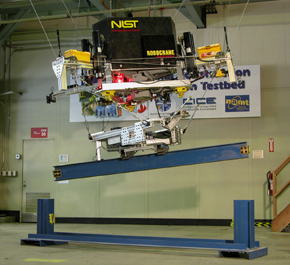|
|
|
|
|
|
|
|
|
|
|
|
 |
 |
 |
 |
|||||||
|
|
||||||||||
 |
 |
 |
 |
 |
 |
 |
 |
|||
BFRL Strategic Goal
Measurement Science for Breakthrough Improvements in Construction Productivity
Autonomous steel beam docking using the NIST RoboCrane™.
What is the problem? The nation and the construction industry face a projected $1.6 trillion cost-burden for renewal of critical physical infrastructure and increased global competition. During the past 40 years, construction productivity has declined at an average annual rate of 0.6 percent. 1 This trend is in stark contrast to all other non-farm industries (e.g., manufacturing) which have improved labor productivity at an average rate of 1.8 percent per year. Industry studies have identified inefficiencies ranging from 25 percent to 50 percent in current methods for coordinating labor and managing, moving and installing construction materials. Other industries have realized their productivity advances largely due to the integration of information, communication, automation, and sensing technologies. Leading industry groups, such as the Construction Industry Institute (CII), Construction Users Roundtable (CURT) and FIATECH, have identified the critical need for fully integrating and automating construction processes. There is a lack of measurement science for determining construction productivity at both discrete and aggregate levels; enabling real-time monitoring and control of construction processes; enabling automated access to and integration of diverse information systems; and evaluating (and thus proving) the performance of promising automation and integration technologies in construction. Creating and validating the needed measurement science requires a neutral, representative, and accurately monitored environment in which the application of new construction technologies and processes can be evaluated.
Why is it hard to solve? These measurement problems are hard because of the complexity and variability of construction (both the construction process and the built product), the unstructured environment of a construction site, and the inefficient processes in place for coordinating labor and movement of components. Large construction projects involve the design, selection and installation of millions of individual products. Some are manufactured off site, some are manufactured on site, and some are assembled on site from manufactured components. Designing, constructing, and commissioning a building involves hundreds to thousands of contractors, each with unique roles and relationships to the others. Each contractor uses unique processes, software tools and technologies to execute their portion of the work. Variability comes from the fact that each building is one-of-a-kind, each building project is a unique combination of participating organizations, and construction site conditions change continuously. This distinguishes construction from manufacturing, which is characterized by an environment that is carefully designed and controlled to efficiently and precisely repeat operations that produce multiple copies of the same product.
Why BFRL? BFRL is uniquely positioned to analyze the industry’s needs, synthesize and apply relevant advancements from other research and industries, and develop and validate the missing measurement science needed for achieving breakthrough improvements in construction productivity. This strategic goal leverages the BFRL core competency in information, communication and automation technologies for intelligent integration of building design, construction and operation and the BFRL network of industry and research partnerships. The development of the needed measurement science and the use of testbeds will provide the tools and catalysts for a broad range of productivity improvements.
Now is the time for BFRL to succeed in achieving these breakthrough improvements because the enabling technologies are sufficiently mature to be applied to construction processes, the cost of computing is no longer a barrier, and the industry is demanding new capabilities for assessing and improving construction productivity. Industry organizations have confirmed the importance of this goal and are committed to working with BFRL to achieve success. Leaders in the construction industry know the success and benefits that have accrued from the investments in measuring and monitoring construction safety and see the potential for similar improvements in construction productivity.
By working with industry and the research community, BFRL will enable industry to measure construction productivity at discrete and aggregate levels, incorporate automated access to and integration of diverse information systems, and leverage real-time control systems to fully integrate and automate construction processes, resulting in:
[1] Teicholz, P., “Labor Productivity Declines in the Construction Industry: Causes and Remedies,” AECbytes Viewpoint, Issue 4, April 14, 2004.
- Reduction of construction costs and delivery times;
- Increased capabilities to identify and implement productivity-improving practices and technologies;
- Reduced uncertainty, unpredictability and risk in construction processes; and
- New construction processes and capabilities.
Component Programs:
CONSIAT: Construction Integration and Automation Technologies
Contact:
Mark Palmer
301-975-5858
mpalmer@nist.gov
Last updated: 1/5/2009
